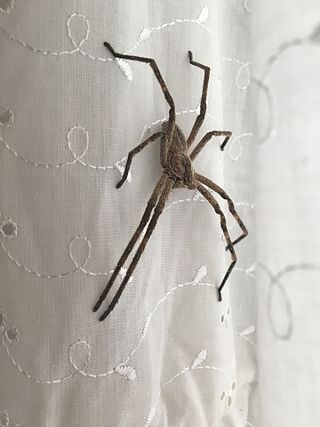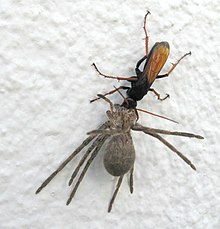
The genus Argiope includes rather large spiders that often have a strikingly coloured abdomen. These spiders are distributed throughout the world. Most countries in tropical or temperate climates host one or more species that are similar in appearance. The etymology of Argiope is from a Latin word argentum meaning silver. The carapace of Argiope species is typically covered in silvery hairs, and when crawling in the sun, they reflect it in a way that gives them a metallic, white appearance.

Huntsman spiders, members of the family Sparassidae, catch their prey by hunting rather than in webs. They are also called giant crab spiders because of their size and appearance. Larger species sometimes are referred to as wood spiders, because of their preference for woody places. In southern Africa the genus Palystes are known as rain spiders or lizard-eating spiders. Commonly, they are confused with baboon spiders from the Mygalomorphae infraorder, which are not closely related.

A tarantula hawk is a spider wasp (Pompilidae) that preys on tarantulas. Tarantula hawks belong to any of the many species in the genera Pepsis and Hemipepsis. They are one of the largest parasitoid wasps, using their sting to paralyze their prey before dragging it to a brood nest as living food; a single egg is laid on the prey, hatching to a larva which eats the still-living host. They are found on all continents other than Europe and Antarctica.

Wasps in the family Pompilidae are commonly called spider wasps, spider-hunting wasps, or pompilid wasps. The family is cosmopolitan, with some 5,000 species in six subfamilies. Nearly all species are solitary, and most capture and paralyze prey, though members of the subfamily Ceropalinae are kleptoparasites of other pompilids, or ectoparasitoids of living spiders.

The redback spider, also known as the Australian black widow, is a species of highly venomous spider believed to originate in Australia but now, Southeast Asia and New Zealand, with colonies elsewhere outside Australia. It is a member of the cosmopolitan genus Latrodectus, the widow spiders. The adult female is easily recognised by her spherical black body with a prominent red stripe on the upper side of her abdomen and an hourglass-shaped red/orange streak on the underside. Females usually have a body length of about 10 millimetres (0.4 in), while the male is much smaller, being only 3–4 mm (0.12–0.16 in) long.

The Goliath birdeater belongs to the tarantula family Theraphosidae. Found in northern South America, it is the largest spider in the world by mass and body length, and second to the giant huntsman spider by leg span. It is also called the Goliath tarantula or Goliath bird-eating spider; the practice of calling theraphosids "bird-eating" derives from an early 18th-century copper engraving by Maria Sibylla Merian that shows one eating a hummingbird. Despite the spider's name, it rarely preys on birds.

Latrodectus geometricus, commonly known as the brown widow, brown button spider, grey widow, brown black widow, house button spider or geometric button spider, is one of the widow spiders in the genus Latrodectus. As such, it is a 'cousin' to the more infamous Latrodectus mactans. L. geometricus has black and white patterns on the sides of its abdomen as well as an orange-yellow colored hourglass shape marking. Their eggs are easily identified by points that project from all over the egg sacs. L. geometricus are found all over the world, but are believed to originate in Africa or South America. Their bites, though painful, are not considered to be dangerous.
The wattle bagworm is a species of moth in the family Psychidae. In southern Africa it is a pest of the black wattle which is grown largely as a source of vegetable tannin. Kotochalia junodi is indigenous to Southern Africa, where it originally fed on indigenous relatives of the wattle.

Steatoda nobilis is a spider in the genus Steatoda, known in the United Kingdom as the noble false widow, as it superficially resembles and is frequently mistaken for the black widow and other spiders in the genus Latrodectus. It is often referred to as thefalse widow, although "false widow" is a more general term applied to a wider group of species with this resemblance.[a] It is a moderately medically significant spider, with most bites resulting in symptoms similar to a bee or wasp sting. Some bites may cause more significant harm, partly due to pathogenic bacteria from the spiders.

Peucetia viridans, the green lynx spider, is a bright-green lynx spider usually found on green plants. It is the largest North American species in the family Oxyopidae. This spider is common in the southern U.S., Mexico, Central America, and in many West Indies islands, especially Jamaica. Lynx spiders are hunters specialized for living on plants. This species does not use a web to capture its prey. It pounces on its prey in a cat-like manner, which is the reason for the name lynx. It is active during the day.
Hysterocrates gigas is a member of the tarantula family, Theraphosidae found in Cameroon. It is known as the giant baboon spider, Cameroon red baboon spider, or red baboon tarantula.

Episyron quinquenotatus, the white-trimmed black wasp, is a North American species of pompilid spider hunting wasp.

Palystes castaneus is a species of huntsman spider found in parts of South Africa. It is common from Cape Town to Heidelberg, Western Cape, especially in forested areas. In scrub outside forested areas, it is replaced by Palystes superciliosus. It occurs mainly on plants, where it hunts insects. It has a body length of 17–22 mm. P. castaneus is the type species for the genus Palystes, and was first described by Pierre André Latreille in 1819.

Palystes is a genus of huntsman spiders, commonly called rain spiders or lizard-eating spiders, occurring in Africa, India, Australia, and the Pacific. The most common and widespread species is P. superciliosus, found in South Africa, home to 12 species in the genus. The name Palystes is derived from either the Latin palaestes or the Greek palaistes, meaning "wrestler". The genus was first described by Ludwig Carl Christian Koch in 1875.

Anoplius viaticus, commonly known as the black-banded spider wasp, is a species of spider wasp. These wasps are known as spider wasps because the females capture spiders to provide their offspring with food. The paralysed spider is cached in a burrow, the wasp lays an egg on it, and when this hatches, the developing wasp larva consumes the spider. This species is found in sandy heathland across most of Europe.

The rain spider wasp or red-femora spider wasp is an Afrotropical species of spider wasp specialising in capturing spiders of the genus Palystes, the rain spiders.

Hemipepsis tamisieri is a species of afrotropical pepsid spider wasp, one of the so-called tarantula hawks because its preferred prey are tarantulas of the family Theraphosidae.

Pepsis grossa is a very large species of pepsine spider wasp from the southern part of North America, south to northern South America. It preys on tarantula spiders, giving rise to the name tarantula hawk for the wasps in the genus Pepsis and the related Hemipepsis. Only the females hunt, so only they are capable of delivering a sting, which is considered the second most painful of any insect sting; scoring 4.0 on the Schmidt sting pain index compared to the bullet ant's 4.0+. It is the state insect of New Mexico. The colour morphs are the xanthic orange-winged form and the melanic black winged form. In northern South America, a third form, known as "lygamorphic", has a dark base to the wings which have dark amber median patches and a pale tip.

Pison spinolae, commonly known as mason wasp, is a solitary wasp of the family Crabronidae, native to Australia and found throughout New Zealand where it is an introduced species.

Cantuaria borealis is a native New Zealand species of trapdoor spider.
























